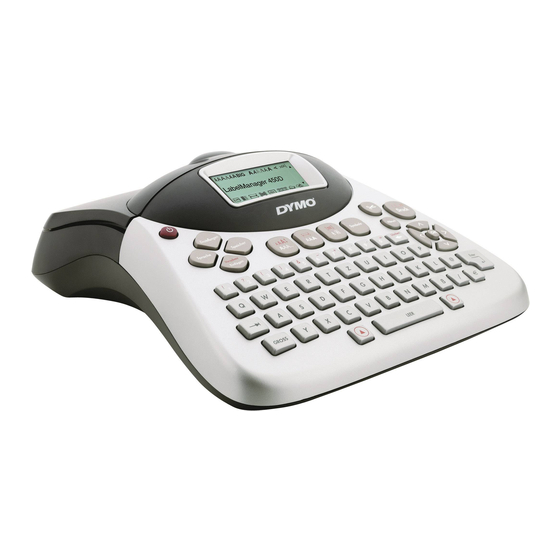Dymo LabelManager 450D Manuel de l'utilisateur - Page 13
Parcourez en ligne ou téléchargez le pdf Manuel de l'utilisateur pour {nom_de_la_catégorie} Dymo LabelManager 450D. Dymo LabelManager 450D 19 pages. Dymo labelmanager user's guide
Également pour Dymo LabelManager 450D : Manuel de l'utilisateur (20 pages), Manuel de l'utilisateur (20 pages), Vue d'ensemble (12 pages), Démarrage rapide (4 pages)

Aligning the Text
When you print a fixed length label you can choose
to align the text at the left, center, or right side of
the label. For multi-line labels, all lines of text are
aligned left, center, and right relative to each other.
To align the text
1. Press
+
.
Shift
2. Use the arrow keys to select the desired
alignment and press
The alignment setting remains active until you reset
the alignment.
Changing the Cutting Option
You can choose to have each label automatically
cut after printing or you can manually cut the labels
using the
key. By default, labels are cut
automatically. When manual cutting is selected and
you print multiple copies or serialized labels, a
dotted cut-line is printed between each label.
To change the cutting option
1. Press
.
Settings
2. Select Set Auto Cut and press
3. Select On or Off, and then press
This setting will remain until you change it.
Adjusting the Print Contrast
You can adjust the print contrast to fine tune the
print quality of your label.
To set the contrast
1. Press
.
Settings
2. Select Set Contrast and press
3. Select a contrast setting and press
Using Labelmaker Memory
The labelmaker has a powerful memory feature
that stores text and formatting as follows:
.
.
.
.
.
• Automatically stores the last fifteen labels
printed.
• Allows you to store the text of up to ten labels
you use frequently.
• Allows you to name and store up to ten
commonly used label formats.
Storing Label Text
The labelmaker automatically keeps the last fifteen
labels printed in a text buffer. In addition, you can
store up to ten specific labels you use frequently.
To store the current label text
1. Press
.
Memory
2. Select Save and then press
3. Use the arrow keys to select Label and then
press
.
Ten fields, which represent memory locations,
are displayed. Fields that are filled indicate
stored label text. You can store new text in any
of the memory locations, however, if you select a
location that is filled, the previous label text will
be overwritten.
4. Select a memory location and press
Your label text is saved and you are returned to the
label.
Storing Formats
In addition to label text, you can store up to ten
specific label formats you use frequently. This
feature stores only the formatting information not
the label text.
To store the current format
1. Press
.
Memory
2. Select Save and press
3. Select Format and press
Ten fields, which represent memory locations,
are displayed. Fields that contain formats
display a name in the field. You can store new
.
.
.
.
13
